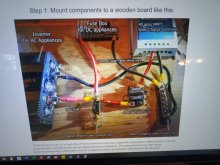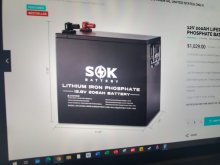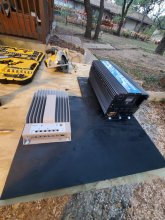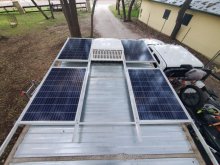N8's Mad Max Camper
New Member
- Joined
- Dec 12, 2020
- Messages
- 3
Hello all. This is my first solar project. I'm building the ultimate off grid camper for my family during these weird times. I'm converting a 16 foot Cargo Craft enclosed trailer into a camper. I've already mounted 4 100W Coleman Crystalline panels on the roof (see picture). I'm putting together the rest to install in the inside of the trailer (per the diagram). I was planning on getting the SOK battery (pictured) to start. I've already purchased a Giandel 4000W Pure Sine Wave Inverter and an 40A Epever Solar Controller (pictured). I like to do things clean and kind of over the top as you can see when it comes to my projects. I bought the book from the creator of this Forum, but I still have a few questions. I've increased the size of the Inverter, so I'm not sure what wiring would help my system run at it's highest potential. I also want to ensure safety since all the wiring will be installed on the inside of the trailer.
1. What gauge wire should I use for the system? Wire from the Solar Controller, from the Battery, from the Inverter, from the panels, etc.
A. Can I just run 4 gauge wire throughout and call it good?
B. Would it improve efficiency if I ran 00 or 2 gauge throughout?
2. Should I run the panels in series or parallel? I want to have just one entry from the roof.
2. Is the recommended 50 Amp circuit breaker for 40 Amp solar Controller sufficient after I've increased the size of my Inverter?
3. The 200 Amp hour SOK battery is near the price of buying a 100 Amp our Battle Born battery. Is it really worth buying 2 Battle Born batteries?
4. What size fuse should I use for my Main fuse according to the diagram I've attached?
5. I want to run 2 freezer/fridge boxes that I've attached a picture of all the time when using the camper. If I want them to always be on when using the trailer, should I use a DC Fuse box that has a "split" layout to make sure that they're always running when plugged in? Or, should I plug them in using a DC extension into the Bus Bar? I could also just plug them into the inverter because both AC and DC plugs come with the unit.
Appreciate any insight my friends. Just glad there's somewhere to go with these questions. I love this kind of shit.
N8
1. What gauge wire should I use for the system? Wire from the Solar Controller, from the Battery, from the Inverter, from the panels, etc.
A. Can I just run 4 gauge wire throughout and call it good?
B. Would it improve efficiency if I ran 00 or 2 gauge throughout?
2. Should I run the panels in series or parallel? I want to have just one entry from the roof.
2. Is the recommended 50 Amp circuit breaker for 40 Amp solar Controller sufficient after I've increased the size of my Inverter?
3. The 200 Amp hour SOK battery is near the price of buying a 100 Amp our Battle Born battery. Is it really worth buying 2 Battle Born batteries?
4. What size fuse should I use for my Main fuse according to the diagram I've attached?
5. I want to run 2 freezer/fridge boxes that I've attached a picture of all the time when using the camper. If I want them to always be on when using the trailer, should I use a DC Fuse box that has a "split" layout to make sure that they're always running when plugged in? Or, should I plug them in using a DC extension into the Bus Bar? I could also just plug them into the inverter because both AC and DC plugs come with the unit.
Appreciate any insight my friends. Just glad there's somewhere to go with these questions. I love this kind of shit.
N8








